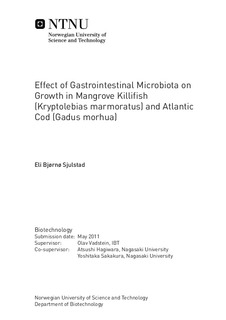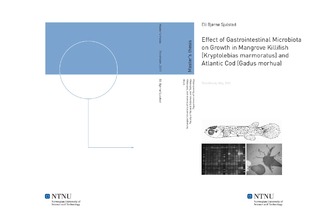| dc.contributor.advisor | Vadstein, Olav | nb_NO |
| dc.contributor.advisor | Hagiwara, Atsushi | nb_NO |
| dc.contributor.advisor | Sakakura, Yoshitaka | nb_NO |
| dc.contributor.author | Sjulstad, Eli Bjørnø | nb_NO |
| dc.date.accessioned | 2014-12-19T13:14:23Z | |
| dc.date.available | 2014-12-19T13:14:23Z | |
| dc.date.created | 2011-06-14 | nb_NO |
| dc.date.issued | 2011 | nb_NO |
| dc.identifier | 422937 | nb_NO |
| dc.identifier | ntnudaim:6458 | nb_NO |
| dc.identifier.uri | http://hdl.handle.net/11250/245659 | |
| dc.description.abstract | All animals live in symbiosis with complex microbial communities. The gastrointestinal system in vertebrates is a natural environment for microbes, and this leads to a complex and numerous microbiota. The gastrointestinal (GI) microbiota has several functions of importance to the host, and the development of molecular biological methods for investigation of microbial communities has lead to a new understanding of this environment. The hypothesis of this thesis was that growth rate in larval fish is partly explained by the composition of the GI microbiota. This was tested by comparing the GI microbiota of slow and fast growing Atlantic cod (Gadus morhua) and mangrove killifish (Kryptolebias marmoratus) of the same age. The GI microbiota was characterized by PCR/DGGE (denaturing gradient gel electrophoresis) and sequencing of bands from the DGGE gels. There was a significant difference between the GI microbiota in fast and slow growing individuals from cod and the mangrove killifish strain DAN. The mangrove killifish strain PAN-RS also showed differences, but these findings were only marginally significant. This can partially be explained by the low number of samples analyzed. The GI microbiota of the PAN-RS juveniles had similarities with the microbial composition of both the feed and water, and showed that the GI microbiota is affected by both. In an experimental test it was attempted to examine if exposure to the culturable microbiota from either slow or fast growing individuals could reproduce size differences. However, the cultured bacteria from fast and slow growing mangrove killifish PAN-RS larvae were not significantly different in composition. Thus it was not expected to find any size difference between the fish larvae supplied with the different cultured bacteria. This was confirmed analytically, but the fish larvae supplied with the bacteria had a larger variation in size than the control group.The results in this thesis indicate a difference in the composition of the GI microbiota between fast and slow growing fish in the early stages of development. Further studies are required to verify if this is a causal relationship where differences in the GI microbiota of individuals results in differences in somatic growth. | nb_NO |
| dc.language | eng | nb_NO |
| dc.publisher | Institutt for bioteknologi | nb_NO |
| dc.subject | ntnudaim:6458 | no_NO |
| dc.subject | MBIOT5 Bioteknologi | no_NO |
| dc.subject | Biokatalyse/Biopolymerkjemi | no_NO |
| dc.title | Effect of Gastrointestinal Microbiota on Growth in Mangrove Killifish (Kryptolebias marmoratus) and Atlantic Cod (Gadus morhua) | nb_NO |
| dc.type | Master thesis | nb_NO |
| dc.source.pagenumber | 77 | nb_NO |
| dc.contributor.department | Norges teknisk-naturvitenskapelige universitet, Fakultet for naturvitenskap og teknologi, Institutt for bioteknologi | nb_NO |

